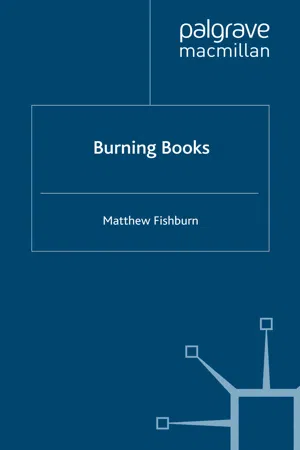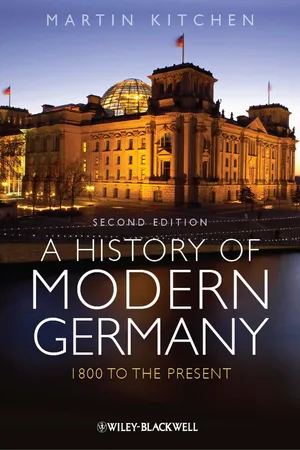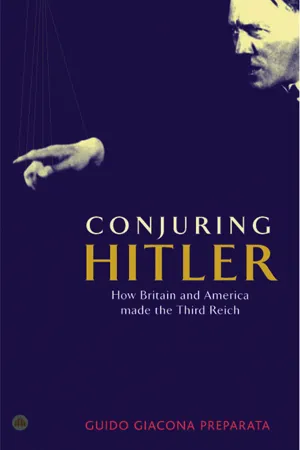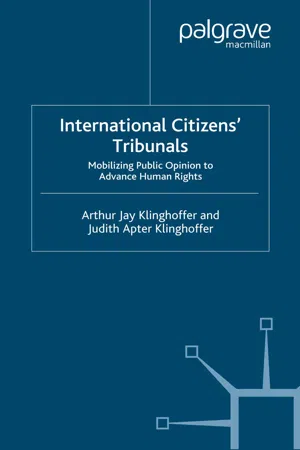History
Reichstag Fire
The Reichstag Fire refers to the arson attack on the German parliament building, the Reichstag, on February 27, 1933. The incident was used by the Nazi Party to justify the suspension of civil liberties and the persecution of their political opponents. It is widely believed that the Nazis themselves orchestrated the fire as a pretext to consolidate their power.
Written by Perlego with AI-assistance
Related key terms
1 of 5
5 Key excerpts on "Reichstag Fire"
- eBook - ePub
Willi Münzenberg
Fighter against Fascism and Stalinism
- John Green(Author)
- 2019(Publication Date)
- Routledge(Publisher)
1The Reichstag Fire was undoubtedly a key moment in Hitler’s bid for total power. It was the tool he desperately needed in order to persecute the Communists, Social Democrats, and other non-Nazi parties and to destroy liberty throughout Germany.Before the fire, Hitler had headed nothing more than a shaky coalition in which the Nazis had only 3 out of 13 cabinet seats. The fire marked the real beginning of what was arguably the most violently destructive regime in human history.Its historical significance is underlined by Carter Hett, when he says that by firmly establishing the truth around the Reichstag Fire and controlling the narrative of how it happened means to control the narrative of everything that followed.2There is little doubt that Nazis committed this criminal act of arson, entering through secret tunnels that led from Marshal Hermann Göring’s nearby residence, but they immediately placed the blame on the Communists in a well-prepared propaganda coup. It was only one month since Hitler became chancellor.3National elections were due to be held in a few days’ time on 5 March, and although the Nazis were already the largest party in the Reichstag, they needed total control to achieve their goals. Over the next days, following the fire, the police, supported by Nazi Stormtroops swooped on all known Communist and Social Democratic offices, as well as their homes, ransacking the buildings, beating and arresting anyone they suspected of being either a Communist, a Social Democrat, or trade unionist. These will be followed by radical Christians and Jews. No one would ever be punished for these acts of terror. The prisons are stuffed with these ‘enemies of the state’, and the first provisional concentration camps are established. The Nazis achieved their aim, and although the Communist and Social Democratic parties were nominally still allowed to contest the elections, they were in effect outlawed, giving the Nazis a free path to total power. Despite the manipulation, however, the Nazis only managed to win 43.9 per cent of the votes, but that did not hold Hitler back. In June, he simply banned the formation of new parties and declared the NSDAP as the only legal party in the country. - eBook - PDF
- M. Fishburn(Author)
- 2008(Publication Date)
- Palgrave Macmillan(Publisher)
2 THE Reichstag Fire In 1933 the fire at the centre of media attention and propaganda struggles was not the book burnings, but the arson attack on the Reichstag on the 49 50 Burning Books night of 27 February. News that the German Parliament building was burning galvanized politicians and journalists alike; within hours the top Nazi officials were touring the still smouldering building. Although Hitler had long held the Reichstag’s parliamentary function in contempt, and although the only person the police found to arrest at the scene was Marinus van der Lubbe, an apparently mentally disturbed Dutchman, the Nazis were quick to conclude the fire was the blazing signal for Communist insurrection. The Völkischer Beobachter rushed to print a new front page, beginning a propaganda campaign designed to influence the impending elections slated for 5 March. A Cabinet meeting was hurriedly convened, and President Hindenburg signed the hastily drafted Emergency Decree for the Defence of Nation and State the following day, meaning that only a few legal fictions preserved the impression that Germany was under anything less than full martial law. It was, wrote Hans Mommsen, the fundamental ‘blank cheque’ of Nazi rule. 3 The decree enforced restrictions on personal freedom, free speech and the right of association; all forms of communication became subject to surveillance, houses could be arbitrarily searched, and Marxist writings were forbidden. Hitler was careful not to outlaw the Communist Party, but he shattered the German Left by dispatching many of its leaders into concentration camps. Those who remained at large scrambled into exile or went underground. Over the ensuing days, the act of arson became key to National Socialist electioneering. Party posters continued to proclaim that Hitler would eradicate both the Communists and the Social Democrats, but now claimed that only he could put a stop to the revolution intended by the burners of the Reichstag. - eBook - ePub
A History of Modern Germany
1800 to the Present
- Martin Kitchen(Author)
- 2011(Publication Date)
- Wiley-Blackwell(Publisher)
Volksgemeinschaft ) that would transcend all divisions of class and station. The economy would be revitalized in two successive four-year plans. “National rebirth” would result from reasserting family values and Christian morality. He made no concrete proposals, but he spoke with such utter conviction and passion that the crowds believed that he could be trusted. In this highly charged emotional atmosphere what mattered was not a carefully crafted program, but a spontaneous and passionate reaction. The opposition forces were so hopelessly divided, demoralized, and cowed that they could offer precious little resistance.On February 20 Hitler addressed a group of leading industrialists and told them that this would be positively the last election and that he intended to create a strong and independent state, regardless of the outcome of the election. First he had to gain absolute power, and then he would destroy his opponents. The industrialists were delighted, and promptly got out their checkbooks. The party was thereby relieved of all financial worries.The Reichstag FireAt nine o’clock in the evening of February 27 smoke was seen billowing through the roof of the Reichstag. Shortly afterwards a dim-witted Dutch anarchist, Marinus van der Lubbe, was arrested in the Bismarck Room. He promptly admitted that he had set the building on fire. The National Socialists convinced themselves that this was part of a Communist plot. Their opponents claimed that the Nazis had organized the fire in order to find an excuse to bring in further emergency legislation. The Communists soon published a “Brown Book” that purported to show Nazi complicity in the fire.The Nazi claim that van der Lubbe was under orders from the Communists was soon shown to be utterly false. Communists later admitted that their “Brown Book” was a fabrication. In 1962 Fritz Tobias published a detailed study of the Reichstag Fire and came to the conclusion that van der Lubbe acted alone. Most historians now accept this version, although some respected scholars still believe that the Nazis were implicated.When Hitler was told of the fire he wound himself up into a passion and said that all Communist functionaries should be shot, their Reichstag deputies hanged. The Prussian ministry of the interior promptly set about drafting an emergency decree. On the following day the “Decree for the Protection of the People and the State” was promulgated. All the fundamental rights guaranteed in the constitution were suspended. The death penalty was extended to include a number of crimes, including treason and arson. Summary arrests could be made and the Nazis’ opponents placed in “protective custody” in concentration camps. In an important step towards dismantling the republic’s federal structure, Wilhelm Frick as minister of the interior could disregard the sovereignty of the states if he deemed that law and order were in jeopardy. This decree, which claimed to be solely directed against the Communists, was the fundamental law on which the Nazi dictatorship was based. It remained in force in spite of the fact that van der Lubbe’s trial in September clearly showed that there was no evidence that the Communists were involved. The accused was executed even though arson was not a capital offense at the time he committed the crime. There was a wave of arrests throughout Germany. 100,000 people, mostly Communists, were arrested in Prussia, among them the prominent left-wing writers Egon Erwin Kisch, Erich Mühsam, Carl von Ossietsky, and Ludwig Renn. - eBook - PDF
Conjuring Hitler
How Britain and America Made the Third Reich
- Guido Giacomo Preparata(Author)
- 2005(Publication Date)
- Pluto Press(Publisher)
The Führer was summoned at once to the site. Upon reaching the smoldering remains of what used to be the Parliament, he exclaimed: ‘This is a beacon from heaven...No one can now prevent us from crushing the Communists with a mailed fist.’ 11 Even Göring arrived, overexcited – the emotion of both leaders appeared genuine. According to the official version, the Reichstag Fire was an ‘act of terrorism,’ a Communist crime. Yet attempts at sedition were witnessed nowhere round the country. All was silent. Lists of arrests, which had been prepared long before, led to the incarceration of several thousand Communist and Socialist activists – the Gestapo came into being, and the camps received their first inmates. On February 28, the KPD (German Communist Party) was outlawed. Meanwhile, the electoral push was intensified by the squawking of slogans, torch-lit processions, marches and drills. On March 5, on election day, despite the prodding of the terrorist antics and loads of cash from I. G. Farben, 12 the Nazis were still not capable of reaping a majority: they accumulated 43.9 percent of the ballot, which only with an 8 percent nudge from the moribund Nationalists, allowed them to form a qualified quorum in the House. In its war against terror, the government issued two ordinances, on February 28 and March 7, respectively, ‘for the defense of the people and the state,’ which restrained the freedom of the press, individual liberties, and the right of assembly. On March 12, the swastika-crested flag of the party was promoted to National Ensign. Having the Reichstag burned to the ground, the congress convened in the Kroll Opera House on March 23. No Communists in the House; with the ‘suspension’ of 30 additional Socialists, the number of representatives had been reduced by 109: the remaining deputies were asked to pass an Enabling Act which would have given the government the right for four years to legislate by decree, without constitutional restrictions. - eBook - PDF
International Citizens' Tribunals
Mobilizing Public Opinion to Advance Human Rights
- A. Klinghoffer(Author)
- 2002(Publication Date)
- Palgrave Macmillan(Publisher)
Mounting the ideological barricades, he declared: “In our view, all criminals against the State are Marxists. The Reichstag Fire was a crime against the State. Therefore we arrested all Marxists.” 21 34 The Reichstag Fire Case Goering sarcastically observed: “If communism had won, you gentlemen would not be sitting here. The revolutionary tribunal of Herr Dimitrov would have used a shorter procedure.” 22 The charged ideological atmosphere produced a flap right at the outset when two Soviet journalists working for Tass and Izvestiia, respectively, were taken from their beds to police headquarters. They were held for eight hours, and released after a protest from the Soviet embassy. The Leipzig police chief apologized, blaming subordinates for “mistakes.” Hitler used the occasion to suggest that relations with Moscow were not strong, but he didn’t want to provide any pretext for breaking them. 23 Dimitrov’s important Comintern role was not revealed in court until the very end of the trial, and Goering explained while testifying: “What hap- pens in Russia is of no interest to me. I have only to deal with the German Communist Party, and with the foreign crooks who come here to fire the Reichstag.” 24 The Leipzig trial demonstrated that accusations by the Commission of Inquiry had to be parried in order to assure world public opinion, which was generally skeptical about Nazi justice. Not only did Nazi leaders rally to protect their government’s image, but the Supreme Court did not resort to any in camera sessions that were legally permissible. The court also did not interfere with the defense’s right to present its own witnesses available in Germany, nor with the ability of defense witnesses to assist their clients, and it organized an inspection of the tunnel from Goering’s residence to the Reichstag as an obvious response to allegations raised at the counter- trial and in the “Brown Book,” regarding Nazi complicity.
Index pages curate the most relevant extracts from our library of academic textbooks. They’ve been created using an in-house natural language model (NLM), each adding context and meaning to key research topics.




